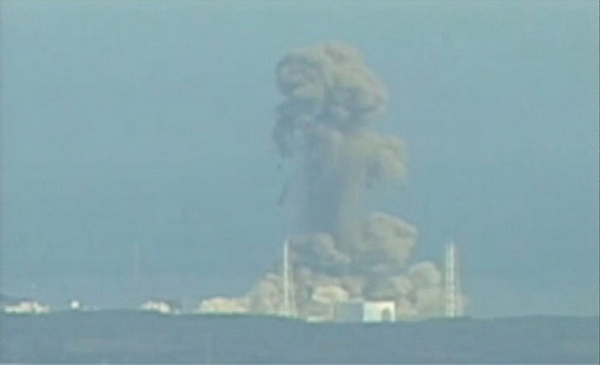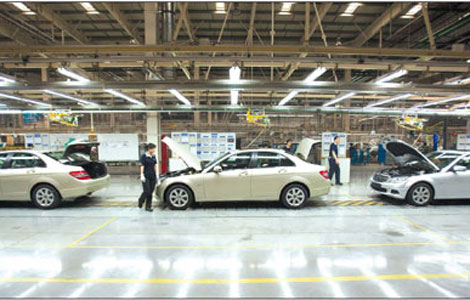Asia
Second blast at Japan nuke plant
Updated: 2011-03-14 16:08
(Agencies)
|
 Smoke rises from Fukushima Daiichi nuclear power complex in this still image from video footage March 14, 2011. [Photo/Agencies] |
The second hydrogen explosion in three days rocked Japan's stricken Fukushima Dai-ichi nuclear plant Monday, sending a massive column of smoke into the air and wounding 11 workers.
Hours later, the US said it had shifted its offshore forces away from the plant after detecting low-level radioactive contamination.
The aircraft carrier USS Ronald Reagan was about 100 miles (160 kilometers) offshore when it detected the radiation, which US officials said was about the same as one month's normal exposure to natural background radiation.
It was not clear if the radiation had leaked during the Monday explosion. That blast was felt 25 miles (40 kilometers) away, but the plant's operator said radiation levels at the reactor were still within legal limits.
The explosion at the plant's Unit 3, which authorities have been frantically trying to cool after a system failure in the wake of Friday's massive earthquake and tsunami, triggered an order for hundreds of people to stay indoors, said Chief Cabinet Secretary Yukio Edano. The two disasters left at least 10,000 people dead.
Operators knew an explosion was a possibility as they struggled to reduce pressure inside the reactor containment vessel, but apparently felt they had no choice if they wanted to avoid a complete meltdown. In the end, the hydrogen in the released steam mixed with oxygen in the atmosphere and set off the blast.
Tokyo Electric Power Co., which operates the plant, said radiation levels at Unit 3 were well under the levels where a nuclear operator must file a report to the government.
On Saturday, a similar explosion took place at the plant's Unit 1, injuring four workers and causing mass evacuations.
Shortly after the Monday explosion, Tokyo Electric warned it had lost the ability to cool Unit 2. Takako Kitajima, a company official, said plant workers were preparing to inject seawater into the unit to cool the reactor.
The Unit 3 reactor's inner containment vessel holding nuclear rods was intact, Edano said, allaying some fears of the risk to the environment and public. TV footage of the building housing the reactor appeared to show damage similar to Saturday's blast, with outer walls shorn off, leaving only a skeletal frame.
More than 180,000 people have evacuated the area in recent days, and up to 160 may have been exposed to radiation — pouring misery onto those already devastated by the twin disasters.
While Japan has aggressively prepared for years for major earthquakes, reinforcing buildings and running drills, the impact of the tsunami — which came so quickly that not many people managed to flee to higher ground — was severe.
By Monday, officials were clearly overwhelmed by the scale of the crisis, with millions of people having spent three nights without water, food or heat in near-freezing temperatures. At least 1.4 million households had gone without water since the quake struck and some 1.9 million households were without electricity.
Officials in one devastated town said they were running out of body bags.
Officials have declared states of emergency at six Fukushima reactors, where Friday's twin disasters knocked out the main cooling systems and backup generators. Three are at Dai-ichi and three at the nearby Fukushima Daini complex.
Most attention, though, has been focused on Dai-ichi units 1 and 3, where operators have been funneling in seawater in a last-ditch measure to cool the reactors. A complete meltdown — the melting of the radioactive core — could release radioactive contaminants into the environment and pose major, widespread health risks.
Edano said no Fukushima reactor was near that point, and he was confident of escaping the worst scenarios.
International scientists say there are serious dangers but little risk of a Chernobyl-style catastrophe. Chernobyl, they note, had no outer containment shell.
"The likelihood there will be a huge fire like at Chernobyl or a major environmental release like at Chernobyl, I think that's basically impossible," said James F. Stubbins, a nuclear energy professor at the University of Illinois.
But despite official assurances, many residents expressed fear over the situation.
"First I was worried about the quake," said Kenji Koshiba, a construction worker who lives near the plant. "Now I'm worried about radiation." He spoke at an emergency center in Koriyama, about 40 miles (60 kilometers) from the most troubled reactors and 125 miles (190 kilometers) north of Tokyo.
Overall, more than 1,500 people had been scanned for radiation exposure in the area, officials said.
The UN nuclear agency said a state of emergency was also declared Sunday at another complex, the Onagawa power plant, after higher-than-permitted levels of radiation were measured there. It said Japan informed it that all three of those reactors there were under control.
Four nuclear complexes in northeastern Japan have reported some damage from the quake or the tsunami.
E-paper

Factory fever
Despite auto manufacturing bubble scare, car giants gear up expansion of factories.
Dressed for success
Fabric of change
High spirits
Specials

Earthquake Hits Japan
A massive 8.8 magnitude quake hit the northeast coast of Japan on March 11,2011.

NPC & CPPCC sessions
Lawmakers and political advisers gather in Beijing to discuss major issues.

Panda campaign
Black-and-white bear helps Chengdu in marketing campaign after quake.
